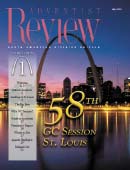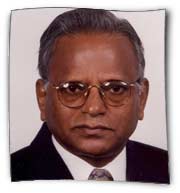 |
||
Life--its meaning, purpose, and destiny--may seem elusive to so many, so often. But to these students in Madurai and to a million more around the world, life becomes a challenge--to live, to be mastered, and to make it useful for both now and eternity, for both their home and their community, for both their country and the world. That's what Seventh-day Adventist education is all about: to let the Word be the light of the way. Assisting in this process are some 70,000 teachers in 5,300 primary schools, 1,320 secondary schools, and more than 100 colleges and universities. Adventist educational institutions are scattered around the globe, from Moscow to Melbourne, from Hong Kong to Honolulu. The variety of institutions ranges from the pinnacle of science and medicine (Loma Linda University) to probing the depths of God's self-disclosure (the Seventh-day Adventist Theological Seminary, Andrews University) to teaching "Jesus loves me! this I know" to tiny tots in tiny villages. "Something better" has always been the watchword of Adventist education. The guiding philosophy of Adventist education is wholistic development of the individual in physical, mental, social, and spiritual dimensions. This is no theory, but is ingrained in every curriculum, written on every chalkboard, and impressed upon every heart.
South Korea's Sahmyook University and College continue to dominate the educational map of that country. Enrollment for 2004 crossed the 6,200 mark in 25 departments. The university's 155 full-time professors, assisted by 180 staff members and 400 part-time faculty, are committed to imparting an education that excels in academics and integrates learning with faith. A feature of the university is its high intake of non-Adventist students at the beginning of the college year. Last year, 1,700 of the 2,000 freshmen were non-Adventists. But the university faculty and Adventist students are committed to turning every dorm room and every class appointment into a mission field. Witnessing, sharing, just being friendly, bringing a friend to Sabbath school--and every other conceivable approach--led to 900 baptisms at the end of the college year. Matthew 28:19 is still the binding focus of Adventist education--not just in Seoul, but also in every great and small center of Adventist learning. Call it the reach-out dimension. Southern Asia-Pacific Division has perhaps the highest number of educational institutions in the world. The church has an educational program in all the 17 countries of the division, with the total being 1,000 institutions, 5,000 teachers, and more than 100,000 students. The division has 15 colleges, including the prestigious AIIAS (Adventist International Institute of Advanced Studies), an international university of renown, and Adventist University of the Philippines, a pioneering institution still breaking new ground, the latest being a College of Dentistry. But the singular point that marks the educational institutions of this division is soul winning and church growth. In this vital field of outreach, inreach, and nurture, it is the students who lead. Stand on a Sabbath morning outside Mountain View College in the southern Philippines, and the sight is simply moving. Hundreds of young people go out in jeepneys--that country's mass (and cheap) transit--to tens of villages within a radius of about 40 miles, to care for a church, to conduct a Sabbath school, or to try out an evangelistic outreach. Call it nurture in action. Just a few years ago Helderberg College in South Africa was like the city of Athens before the Pentecostal converts and Barnabas entered. The college reflected the culture of the country--racially exclusive, divisive in its functioning, although hoping for oneness someday. But today the college is an oasis of unity where Black and White, poor and rich, rural and urban can sit side by side to learn of science and math and at the same time to drink of the water of life freely from a common fountain, cleansed by the blood that was shed 2,000 years ago. Call it a liberating and uniting education. The division in which Adventism was born and Adventist education found its rooting is ever on the high road of excellence. That mark of Christian achievement and service is noted not just in academic heights, but on the road to Jericho as well as at the well of Samaria. Loma Linda University's good Samaritans rushed to Afghanistan to provide much-needed medical education and health ministry, to Adventist colleges in Asia and Africa to establish a nursing school or to spread the good news of public health or to give a helping hand in founding a college of dentistry, even as they fixed a baby's heart or brought nuclear power to crush a devastating cancer cell. Andrews University continues to be on the cutting edge of missions--in providing leadership to colleges abroad, in training the best of leadership that will keep the flag of Adventist faith flying high all over the globe. The North American Division Education Department has chartered a Journey to Excellence, a dynamic new K-12 curriculum and professional development program. Call it the global service dynamic. The journey that began with Martha Byington, teacher of the
first Adventist elementary school (1853), and had its philosophic and theological
moorings in Ellen White's writing is still a call and a march. It is a call
in South America, where governments and the public see in Adventist education
something new, something transforming. It is a march in Europe, where it has
to establish its credentials among ancient traditionalists and modern secularists.
It is a call to keep the flag of Adventism flying in Africa as well as Australia
and in the thousand islands washed by the sea. But the most beautiful sea of
it all--the sea of glass--is the goal toward which Adventist education is focusing
so that all those who pass through its influence may one day be found on the
beach of that mysterious sea of the future. |
 |
 |



 hen the south Indian city of Madurai wakes up on any weekday,
two sights cannot but grip a visitor for their grandeur and their abiding search.
Even before dawn, hundreds of women, freshly bathed and draped in clean saris,
with long wet hair swinging down their spine, march toward the center of the
city. A few hours after the dawn, some 6,000 young people, ranging from 5 to
18, dressed in smart gray uniforms and blue ties with "SDA" on them,
leave their homes for one of five schools scattered around the city. The first
group, the women, seeks to worship a goddess whose history and fame is as ancient
as that of Diana of Ephesus. The second group, the students, flock to schools--to
learn, to discover, to study, to search--not just the way of the academic, but
to find the "more excellent way," the why, the what, and the wherefore
of life.
hen the south Indian city of Madurai wakes up on any weekday,
two sights cannot but grip a visitor for their grandeur and their abiding search.
Even before dawn, hundreds of women, freshly bathed and draped in clean saris,
with long wet hair swinging down their spine, march toward the center of the
city. A few hours after the dawn, some 6,000 young people, ranging from 5 to
18, dressed in smart gray uniforms and blue ties with "SDA" on them,
leave their homes for one of five schools scattered around the city. The first
group, the women, seeks to worship a goddess whose history and fame is as ancient
as that of Diana of Ephesus. The second group, the students, flock to schools--to
learn, to discover, to study, to search--not just the way of the academic, but
to find the "more excellent way," the why, the what, and the wherefore
of life.  Leaving all the convenience and the excellent educational sources
of Nairobi, Kyavu chose to study in the University of Eastern Africa, Baraton,
a rural center. Why did this non-Christian young man choose an Adventist university
when he could have been in the finest and most comfortable learning center in
Kenya? His answer is simple: Baraton is known for building people, without neglecting
academic excellence. "I want my mind to grow," says Kyavu, "my
body to be clean and strong, and my soul to be on the right track." Call
it the wholistic grounding.
Leaving all the convenience and the excellent educational sources
of Nairobi, Kyavu chose to study in the University of Eastern Africa, Baraton,
a rural center. Why did this non-Christian young man choose an Adventist university
when he could have been in the finest and most comfortable learning center in
Kenya? His answer is simple: Baraton is known for building people, without neglecting
academic excellence. "I want my mind to grow," says Kyavu, "my
body to be clean and strong, and my soul to be on the right track." Call
it the wholistic grounding.